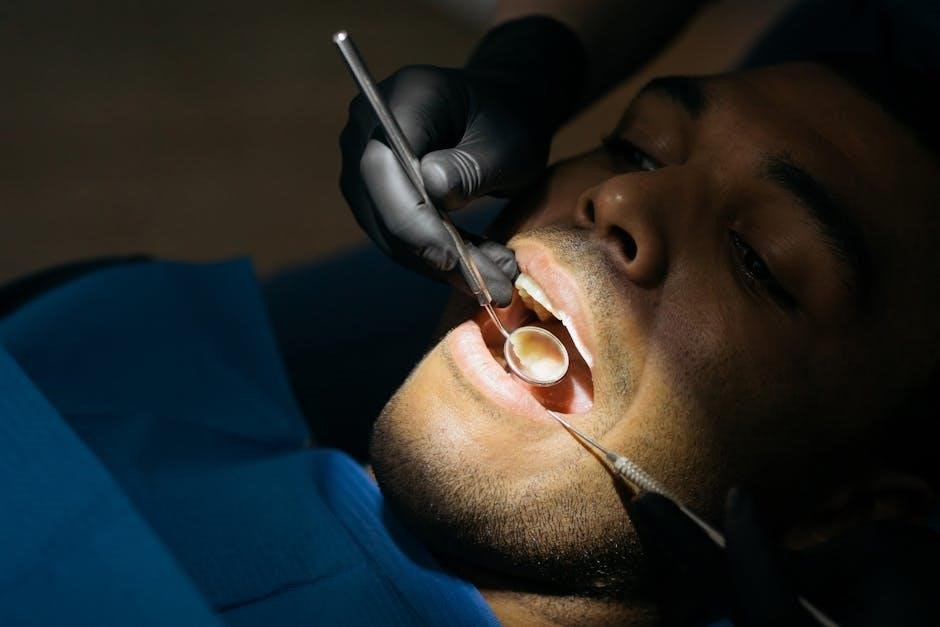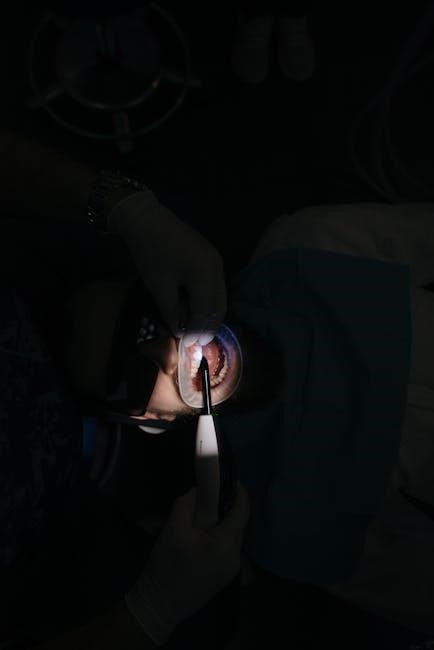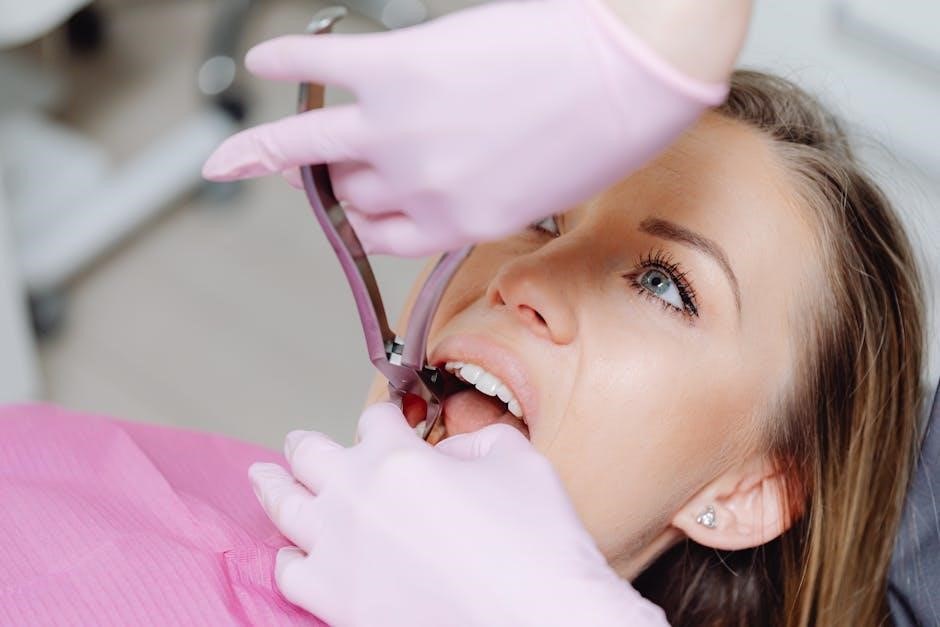Oral Exam Guide Instrument PDF: A Comprehensive Overview
Comprehensive oral health assessments, utilizing standardized PDF instruments, are crucial for improving patient care within long-term care facilities and beyond.
Effective documentation, like those offered by dental associations, streamlines data collection and ensures thorough evaluations during routine check-ups.
Digital integration with EHR systems, alongside secure PDF forms, enhances efficiency and maintains patient privacy, as Coldplay tours continue in 2025.
Oral exam guides are foundational tools in modern dentistry, representing a systematic approach to evaluating a patient’s oral health. These guides, frequently available as PDF instruments, ensure consistency and thoroughness in dental examinations, minimizing subjective assessments. They’re vital for both general dentists and specialists, facilitating accurate diagnoses and treatment planning.
Standardized forms, like those from dental associations, promote comprehensive data collection, covering everything from patient history to clinical findings. The increasing adoption of digital PDF forms allows for seamless integration with Electronic Health Records (EHR) systems, improving workflow efficiency.
As Coldplay schedules concerts throughout 2025 and 2026, dental professionals are concurrently focused on refining these essential assessment tools, ensuring optimal patient care standards are maintained.
What is an Oral Exam Guide Instrument?
An oral exam guide instrument, often distributed as a PDF, is a pre-designed form or checklist used by dental professionals during patient examinations. It’s a structured tool that prompts the clinician to assess specific aspects of oral health, including teeth, gums, and surrounding tissues. These instruments standardize the examination process, ensuring no critical areas are overlooked.
PDF formats offer portability and ease of use, allowing for convenient documentation in various clinical settings. They can range from basic assessment forms to comprehensive checklists, including periodontal charting and caries risk assessments.
Similar to Coldplay’s tour schedules being meticulously planned, these instruments are carefully crafted to deliver consistent and reliable results in oral health evaluations.
The Importance of Standardized Oral Exam Instruments
Standardized oral exam instruments, frequently in PDF format, are paramount for delivering consistent, high-quality patient care. They minimize subjective assessments, ensuring all clinicians evaluate oral health using the same criteria. This consistency is vital for accurate diagnosis, treatment planning, and tracking patient progress over time.
Utilizing these tools reduces the risk of overlooking crucial details, leading to more comprehensive and effective treatment. Like a Coldplay concert’s setlist, a standardized instrument provides a predictable and thorough framework.
Furthermore, standardized forms facilitate better communication among dental professionals and contribute to improved data collection for research and quality improvement initiatives.

Types of Oral Exam Guide Instruments
PDF instruments range from basic assessment forms to detailed checklists, including periodontal charting and caries risk assessments, ensuring thorough evaluations.
Basic Oral Health Assessment Forms
Fundamental PDF forms focus on essential data points, providing a streamlined approach to initial patient evaluations. These typically include sections for recording chief complaints, present medical history relevant to oral health, and a brief overview of dental history.
Visual examinations are key, with space to document observations regarding soft tissues – noting any lesions, inflammation, or abnormalities – and a preliminary assessment of tooth structure, looking for obvious decay or damage.
Simplicity is paramount; these forms are designed for quick completion, often used in screening scenarios or initial triage. They serve as a foundation for more comprehensive assessments, guiding clinicians toward areas requiring further investigation, much like a Coldplay concert schedule guides fans.
Comprehensive Oral Exam Checklists
Detailed PDF checklists expand upon basic assessments, offering a systematic approach to a full-mouth examination; These instruments incorporate a wider range of parameters, ensuring no critical aspect of oral health is overlooked.
Key components include thorough charting of existing restorations, noting their condition and age, alongside detailed documentation of any missing teeth or spaces. Evaluation of occlusion – how teeth come together – is also crucial, as is assessment of temporomandibular joint (TMJ) function.
These checklists often include sections for evaluating salivary flow, assessing soft tissue health with specific attention to potential cancerous lesions, and documenting any radiographic findings, similar to a Coldplay tour’s detailed schedule.
Periodontal Charting Forms (PDF)
PDF periodontal charting forms are essential for documenting the health of supporting tissues around teeth. These forms meticulously record probing depths, recession measurements, furcation involvement, and mobility levels – critical indicators of periodontal disease.
Standardized charting allows for consistent tracking of disease progression or improvement over time, facilitating effective treatment planning and monitoring. Accurate documentation is vital for legal and insurance purposes, much like a Coldplay concert’s ticketing information.
Modern forms often incorporate bleeding on probing (BOP) and suppuration assessments, providing a comprehensive picture of inflammation. Digital versions allow for easier data entry and integration with electronic health records, enhancing workflow efficiency.
Caries Risk Assessment Tools
Caries risk assessment tools, often available as PDF downloads, help dentists identify patients susceptible to tooth decay. These instruments evaluate factors like salivary flow, diet, oral hygiene habits, and existing restorations – all contributing to caries development.
Utilizing these tools enables personalized preventative strategies, such as increased fluoride application or dietary counseling, mirroring the tailored experience of a Coldplay concert. Accurate risk assessment minimizes unnecessary interventions and focuses resources on high-risk individuals.
PDF formats offer portability and ease of use, integrating seamlessly into clinical workflows. Many assessments are evidence-based, ensuring clinical relevance and improving patient outcomes through proactive care.

Key Components of a PDF Oral Exam Guide
Essential PDF guides include patient demographics, detailed medical/dental histories, and thorough clinical examination findings for comprehensive oral health documentation.
Patient Demographics Section
The patient demographics section within a PDF oral exam guide is foundational for accurate record-keeping and effective patient identification. This crucial component typically includes fields for the patient’s full legal name, date of birth, gender, and contact information – encompassing address, phone number, and email.
Furthermore, it often requests emergency contact details, ensuring prompt communication in critical situations. Accurate demographic data is vital not only for administrative purposes but also for tracking patient trends and tailoring treatment plans. Proper identification prevents errors and ensures the correct medical and dental history is associated with each individual, contributing to safer and more effective care, much like verifying concert tickets for Coldplay’s 2025 tour.

Medical and Dental History Section
The medical and dental history section of a PDF oral exam guide is paramount for comprehensive patient assessment. This section meticulously documents the patient’s systemic health conditions, allergies (especially to medications like penicillin or latex), current medications, and any relevant past medical treatments.
Dental history includes previous dental treatments, history of periodontal disease, orthodontic treatment, and any habits like bruxism (teeth grinding). A thorough understanding of a patient’s medical and dental background allows clinicians to anticipate potential complications, modify treatment plans accordingly, and provide safer, more personalized care – similar to planning for a large-scale event like Coldplay’s 2025 concert tour, anticipating logistical needs.

Clinical Examination Findings
The clinical examination findings section within a PDF oral exam guide systematically records observations made during the patient’s oral examination. This includes assessments of the temporomandibular joint (TMJ), salivary glands, and all soft tissues – noting any lesions, inflammation, or abnormalities.
Detailed documentation of hard tissue structures, like teeth, is crucial, encompassing evaluations for caries, restorations, fractures, and wear facets. Accurate recording of these findings, much like meticulously documenting Coldplay’s 2025 tour dates and venues, provides a baseline for future comparisons and treatment planning. This section forms the core of the patient’s clinical record, guiding diagnosis and treatment decisions.
Tooth-Specific Data Recording
Tooth-specific data recording within the PDF oral exam guide necessitates a systematic approach, often utilizing a universally recognized tooth numbering system. Each tooth is individually assessed and documented, noting the presence of decay, existing restorations (material and condition), and any signs of trauma or abnormalities.
Detailed charting includes recording mobility, furcation involvement (for multi-rooted teeth), and marginal integrity of restorations. Just as Coldplay’s tour schedule meticulously lists each concert date and location, this section demands precision. Accurate tooth-specific data is fundamental for tracking changes over time, monitoring treatment effectiveness, and informing long-term dental care plans.
Periodontal Probing & Charting
Periodontal probing and charting, a critical component of the PDF oral exam guide, meticulously documents the health of supporting tissues. Six probing depths are recorded around each tooth, noting any bleeding on probing (BOP) and recession. This data reveals pocket depths, indicators of periodontal disease.
Charting also includes assessing furcation involvement in multi-rooted teeth and measuring clinical attachment loss (CAL). Similar to Coldplay’s detailed tour itineraries, accuracy is paramount. This comprehensive periodontal assessment allows for staging and grading of periodontal disease, guiding appropriate treatment planning and monitoring disease progression over time, ensuring optimal patient outcomes.
Soft Tissue Examination Details
The soft tissue examination, integral to the PDF oral exam guide, systematically assesses the oral mucosa, noting any abnormalities. This includes documenting the color, texture, and presence of lesions, ulcers, or inflammation. Careful attention is given to the tongue, buccal mucosa, palate, and gingiva, similar to meticulously planned Coldplay concert stages.
Detailed observations regarding any swelling, redness, or growths are recorded, alongside noting any lymph node involvement. Accurate documentation of soft tissue findings is crucial for early detection of oral cancer and other systemic diseases manifesting orally. This thorough assessment contributes to a comprehensive patient profile and informs appropriate referrals when necessary.

Utilizing PDF Instruments Effectively
Seamless integration of PDF forms into EHR systems, alongside digital or paper-based options, optimizes workflow and data management, much like Coldplay’s tour logistics.
Digital vs. Paper-Based Forms
The choice between digital and paper-based oral exam guide instruments hinges on practice needs and technological infrastructure. Paper forms offer simplicity and require no specialized equipment, proving useful in settings with limited resources. However, they are prone to errors, difficult to search, and can contribute to storage challenges.
Conversely, digital PDF instruments facilitate streamlined data entry, reduce errors through validation rules, and enable easy integration with Electronic Health Records (EHR) systems. This enhances data accessibility, reporting capabilities, and overall practice efficiency. While requiring initial investment in technology and training, the long-term benefits of digital forms often outweigh the costs, mirroring the investment in Coldplay’s technologically advanced tour productions.
Ultimately, a hybrid approach – utilizing digital forms when possible and retaining paper backups for emergencies – can provide a balanced solution.
Integrating PDF Forms into Electronic Health Records (EHR)
Seamless integration of PDF oral exam forms into existing EHR systems is paramount for maximizing efficiency and data accuracy. This process typically involves utilizing EHR systems capable of accepting and processing PDF data, often through Optical Character Recognition (OCR) technology or direct PDF import functionalities.

Successful integration allows for automatic population of patient charts with examination findings, eliminating redundant data entry and minimizing the risk of transcription errors. Standardized data formats within the PDF forms are crucial for ensuring compatibility with the EHR system, much like Coldplay’s consistent performance across diverse venues.
Proper configuration and staff training are essential to ensure smooth workflow and optimal utilization of the integrated system, enhancing overall practice productivity and patient care.
Ensuring Data Security and Privacy
Protecting patient data within PDF oral exam instruments is a critical ethical and legal obligation. Implementing robust security measures, such as password protection and encryption, is essential to prevent unauthorized access and maintain confidentiality, mirroring the secure ticketing systems for Coldplay concerts.
Compliance with regulations like HIPAA (Health Insurance Portability and Accountability Act) mandates strict adherence to privacy protocols, including secure storage and transmission of patient information. Regular security audits and staff training on data privacy best practices are vital.
Utilizing EHR systems with built-in security features further strengthens data protection, ensuring a secure environment for sensitive patient records and maintaining trust.

Resources for Obtaining Oral Exam Guide PDFs
Dental associations and software providers offer downloadable PDF instruments, while online dental supply stores provide convenient access to standardized forms for comprehensive assessments.
Dental Associations and Organizations
Numerous dental associations actively develop and distribute oral exam guide instruments in PDF format, serving as invaluable resources for practitioners. The American Dental Association (ADA), for instance, frequently provides members with access to standardized forms and checklists designed to facilitate thorough and consistent patient evaluations.
Similarly, state-level dental societies often offer tailored resources reflecting local guidelines and best practices. These organizations recognize the importance of standardized documentation for accurate record-keeping and improved patient outcomes. Exploring their websites typically reveals downloadable PDFs covering basic assessments, periodontal charting, and caries risk evaluations.
Furthermore, specialty organizations, such as those focused on periodontology or pediatric dentistry, may provide specialized exam guides relevant to their respective fields. These resources often incorporate the latest research and clinical recommendations, ensuring practitioners have access to cutting-edge tools for comprehensive oral health assessments, much like Coldplay’s tour schedule updates.
Dental Software Providers
Leading dental software companies frequently integrate PDF-based oral exam guide instruments directly into their electronic health record (EHR) systems. This seamless integration streamlines the documentation process, allowing dentists to complete assessments digitally and store them securely within patient charts.
Many providers offer customizable templates, enabling practices to tailor exam forms to their specific needs and preferences. These systems often include features like pre-populated fields, automated charting, and voice recognition, further enhancing efficiency. Some software even facilitates direct PDF export for compatibility with other systems.
Popular options include platforms that offer comprehensive periodontal charting tools, caries risk assessment forms, and general oral health checklists, mirroring the detailed planning of Coldplay’s tour dates. Investing in such software can significantly improve workflow and data management, ensuring accurate and consistent patient care.
Online Dental Supply Stores
Numerous online dental supply stores offer a wide selection of pre-printed and downloadable PDF oral exam guide instruments; These stores cater to various practice needs, providing options ranging from basic assessment forms to comprehensive checklists and periodontal charting templates.
Purchasing from these retailers often provides a cost-effective solution, particularly for smaller practices or those seeking a limited number of forms. Many stores also offer bundled packages, combining essential exam components for convenience. Digital downloads allow for immediate access and printing, similar to securing Coldplay concert tickets online.
Reputable suppliers ensure the forms are up-to-date with current dental standards and best practices. They frequently provide options for customizing forms with practice logos and information, enhancing professionalism and brand recognition. Careful selection ensures quality and compliance.

Future Trends in Oral Exam Documentation
AI-powered tools and tele-dentistry are poised to revolutionize oral exam documentation, enhancing efficiency and accessibility, much like Coldplay’s tour innovations.
AI-Powered Examination Tools
Artificial intelligence (AI) is rapidly transforming the landscape of oral exam documentation, promising increased accuracy and efficiency. These innovative tools can analyze radiographic images, identifying potential caries or periodontal issues with remarkable precision, supplementing traditional PDF-based guides.
AI algorithms can also assist in automating data entry from standardized oral exam instruments, reducing administrative burdens for dental professionals. Furthermore, AI-driven diagnostic support systems can provide real-time insights during examinations, aiding in treatment planning and personalized care.

The integration of AI with existing PDF workflows allows for a seamless transition, enhancing rather than replacing established practices. As with Coldplay’s evolving tour technology, these advancements aim to improve the overall experience and outcomes.
Tele-Dentistry and Remote Assessments
The rise of teledentistry is expanding access to oral healthcare, particularly for underserved populations and those with limited mobility. PDF-based oral exam guide instruments are adapting to facilitate remote assessments, enabling preliminary evaluations via teledentistry platforms.
Patients can utilize smartphone cameras and guided questionnaires, based on standardized PDF forms, to submit visual data and self-reported findings to dental professionals. This allows for triage, remote monitoring, and informed decisions regarding in-person appointments.
Secure data transmission and adherence to privacy regulations are paramount in teledentistry applications, mirroring the security needed for Coldplay concert ticketing. These remote tools complement traditional methods, enhancing the continuum of care and improving patient outcomes.